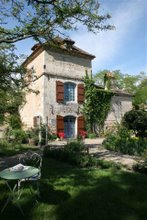
SAUCISSE DE TOULOUSE-
It was nearly a year ago that we danced around the Chinese pig, ate dumplings and spiced pork belly- then got distracted by black truffles and other good winter food. We all declared that night that the year of the pig (as Charcuterie) would go mainstream; we weren’t far wrong.
New books on charcuterie appeared like Ruhlman and Polcyn's Charcuterie or Stephane Reynaud's 'Pork & Sons'; old books resurfaced (I found an old edition copy of Jane Grigson’s ‘the Art of Charcuterie’); several blogs about going whole hog appeared; lots of drying, curing, and stuffing talk at farmer's markets across the lands.
To put in perspective exactly what I do--when I cook and teach is, quite simply, I simplify. Cooking French in France is easy; it should be at home too. I want you to want to cook, not think it's too difficult or not worth the bother. I cut my teeth cooking on a 42-foot yacht before graduating to my own 85 foot barge. Hey, that’s a big boat…but it still has a small galley. These small cooking surfaces informed my style- fast, and the techniques that I use- simple. There are very few appliances due to space and electricity issues when traveling. When I cook in the Relais de Camont- where I teach my classes and workshops, it doesn’t change much. The space is much larger but I still leave the big machines to the fancy schools; it began as an aesthetic decision to fit the 18th century kitchen but I soon realized it fits the way I cook and keeps the focus on the product not the technique. And it is all about the product here in the French Kitchen!
So with that in mind, I’ve invite you to play along and take this virtual charcuterie class with me. Comment to your heart's content, cook along highly encouraged, and questions willingly answered. We begin with the pig, the noble Prince of January, and will tackle a handful of recipes from the classic French repertoire. I am not inventing any of these recipes, and you can search through the 2,000,000+ recipes on line for differences, variations on a theme, and history- some true and some lost in cyberspace fiction. (Remember that game of Telephone? Just imagine what happens with a 100,000 food bloggers pick up and post an ‘authentic’ recipe; by the time it reaches the audience it is sometimes unrecognizable!)
Step#1- a most basic and authentic recipe.

First things First: consider the source. See this man? Mustaches and Beret aside, this is the one of the most trustworthy souls on this earth- Dominique Chapolard, his wife Christiane and brother Mark are the source for these basic French charcuterie recipes- the charcutiers themselves. Before I begin to cook I want to know more about what I am cooking and that lead me to the people who grow the pork, in this case a family of butcher brothers and their wives who run the excellent Ferme Baradieu near Mezin, here in Southwest France. They aren’t the only producer/butchers in this area of the planet, and they might not be the most new wave as far as technique or the most old-fashioned in terms of heritage breeds, but they are caring and careful workers in all they do, from raising the grain they feed their animals to butchering and curing their pork products in the farm laboratoire. I have a special relationship with the family Chapolard because they offered me an inside scoop on their life and work that helped me understand what real porc was all about. I have been barging in to the family farm for several years now and, of course, my own sweet 100 pounds of Bacon de Barici is a true ‘Chapolard de Gascogne’.

On Saturday morning when the lines at the Chapolard “L’Art du Cochon” stand is snaking past the foie gras merchant and over to the poulet rôtissoire, I wait my turn and pray that they don’t run out of Saucisse de Toulouse before I get my turn. It seems that no matter how many kilos they make that week and bring to the market, it all goes home to French households for a Saturday night supper or to use for a Sunday barbeque or in a Classic Cassoulet. So although I have already posted another Saucisse de Toulouse recipe here, I asked Dominique to share their official butcher’s version with us.
Pork
Salt
Pepper
Simple. Very Simple. Not elaborate. A bare minimum of a recipe. And so it makes sense that the very few ingredients used are the best. This is the most important part. I assume that if you are going to the effort to make your own Saucisse de Toulouse you will also go to the effort to buy good quality pork. That’s your first job. FIND THE PORK! So plan to spend a little time to go shopping for good pork. Pasture-raised, organic, natural, massaged or beribboned—it doesn’t matter as long as the quality you buy is the best you can find. I’m preaching to the choir here, so let’s leave it that you will seek out the best quality pork in your shopping circle and commit to learning just what makes Saucisse de Toulouse tick. Our first task in this Saucisse de Toulouse workbook is to get thee to a butcher.

It’s Thursday today, I’ll be going to the market on Saturday. See if you can find some good quality pork shoulder before then. It doesn’t have to be a precise weight. It’s ok to let it sit and rest in your refrigerator until then. What part of the whole hog do you buy? Ask for a whole shoulder roast and a piece of unsalted pork belly (that’s fresh bacon); the natural fat to lean ratio of a good farm-raised pig is about 20-80 and that is what we are looking for. The Label Rouge certificate, much valued here in France, limits fat to 20% in fresh sausages and to meats from noble cuts. So get over the idea that sausage is a catch-all for undisclosed body parts. That is why we are doing this together.
Notes on Seasoning: Traditionally Saucisse de Toulouse is quite simply- just fresh sausage and is deceptively simple for that reason. Salt seasons and helps cure the meat but there are no masking herbs and spices (except pepper) to hide the quality of the meat. Recipes for Saucisse de Toulouse often add different flavorings like garlic, nutmeg, and sugar; It has been said that in Toulouse white wine is used and my farm neighbors here in the Southwest routinely add a pinch of épice Rabelais, a commercial secret blend of charcuterie spices that can be dangerously heavy on cloves; I do love the package but use it with a very restrained hand.

While you are checking your cupboard, make sure you have sea salt (coarse or fine) and fresh black peppercorns. That's it. By no accounts do you want to see this on the label of any sausage you make:
Viande de porc 88%, sel, acidifiant E325,E262, sucres: saccharose, lactose, dextrose de blé, épices et aromates (moutarde), exhausteur de goût E621, colorants : E100 et E120, antioxydants E316 et E300
rather the Label Rouge for Saucisse de Toulouse designates "sans colorant ni conservateur"- no coloring and no preservatives.
Sausage casings: this might be trickier depending on your neck of the woods. In these here French woods, even the supermarket, in the small country towns, will carry natural sausage casings. we are looking for about 25mm or 1 inch casing; Saucisse de Toulouse is a generous size sausage. Ask the butcher or maybe comment on where you found sausage casings chez vous! in a worse case scenario you can make crepinettes, little fla patties wrapped in caul fat. where do you get caul fat? Same place you get sausage casings.:)

Notes On Machinery. If you are talking to a real butcher, I mean a live human being like the charming Butcher of Moissac above, then ask him to grind the pork shoulder for you. Now that’s easy! If you live in plastic-wrap land, when you get that hunk of meat home, take it out of the plastic, rinse it, dry it and wrap it in a tea towel or cover with parchment paper and refrigerate. We’ll grind it later. Oops! don’t own a grinder. Well, hang tight and let’s see how easy we can make this. Get your knives sharpened. Anyone wishing have some more kitchen toys, oops, I mean tools, can find all the grinders you want here.
But first we’re going to take a little trip to the farm and learn a bit about pig raising in Gascony...






























